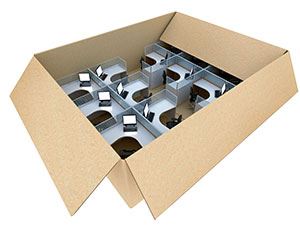 “Plans are useless but planning is indispensable,” said former American President Dwight D. Eisenhower. What he says rings true for any situation. It’s important to plan because that gets and keeps things on the right track. But no matter how much you plan, your plans won’t fit every situation perfectly. So from a high level, this is what you should do for office moving: 1. Have a Clearly Stated Need/Goal for Your Office Move Are you doing this to get out of a bad lease? Are you planning on explosive growth? What is it you want to get from this move? You need to figure this out from the onset of your move because that creates the basis for all decisions going forward. This saves time and smooths the rest of the moving process ahead of you. 2. Planning This should begin 12 months before you actually want to move, says UK company Morgan Lovell. The person you put in charge of your move should have a fairly senior position, know how to multitask well, be able to motivate your employees, communicate clearly, be organized, and know how to adhere to a budget. 3. Find Your Office Space We could spend a whole guide on this part of the process alone. Quickbooks advises you analyze your company’s needs before making any decisions. And of course, only rent what you really need. So many businesses fall into the trap of overpaying for excess office space or functionality that won’t get put to use. Websites like OfficeSpace.com give you complete pricing information for major markets. 4. Lease Negotiation Nolo.com says the initial lease terms almost always favor your landlord. But they’re pretty easy to renegotiate with a little effort. It says shorter leases are generally to your advantage. You can negotiate this by asking for renewal options, and typically the landlord wants more rent during the renewal period. Take it if he offers it. 5. Office Design & Build Depending on what type of company you are, you might want to hire a consultant to help you with this. Inc.com wrote an article on designing an office for maximum creativity. Some tips they recommend include:
“Plans are useless but planning is indispensable,” said former American President Dwight D. Eisenhower. What he says rings true for any situation. It’s important to plan because that gets and keeps things on the right track. But no matter how much you plan, your plans won’t fit every situation perfectly. So from a high level, this is what you should do for office moving: 1. Have a Clearly Stated Need/Goal for Your Office Move Are you doing this to get out of a bad lease? Are you planning on explosive growth? What is it you want to get from this move? You need to figure this out from the onset of your move because that creates the basis for all decisions going forward. This saves time and smooths the rest of the moving process ahead of you. 2. Planning This should begin 12 months before you actually want to move, says UK company Morgan Lovell. The person you put in charge of your move should have a fairly senior position, know how to multitask well, be able to motivate your employees, communicate clearly, be organized, and know how to adhere to a budget. 3. Find Your Office Space We could spend a whole guide on this part of the process alone. Quickbooks advises you analyze your company’s needs before making any decisions. And of course, only rent what you really need. So many businesses fall into the trap of overpaying for excess office space or functionality that won’t get put to use. Websites like OfficeSpace.com give you complete pricing information for major markets. 4. Lease Negotiation Nolo.com says the initial lease terms almost always favor your landlord. But they’re pretty easy to renegotiate with a little effort. It says shorter leases are generally to your advantage. You can negotiate this by asking for renewal options, and typically the landlord wants more rent during the renewal period. Take it if he offers it. 5. Office Design & Build Depending on what type of company you are, you might want to hire a consultant to help you with this. Inc.com wrote an article on designing an office for maximum creativity. Some tips they recommend include:
- Branding your space with objects
- Observing how your staff currently uses your office
- Zone your office just like cities zone themselves
6. IT Relocation We’re not going to lie – this may be one of the most difficult steps in your move. Here’s what MyMovingReviews.com advises:
- Make a relocation checklist for your server room
- Notify your personnel
- Make a backup of everything on your server
- Take photos of how your equipment is currently connected
- Prepare your future office for the equipment
- Have contingency plans in place in case something doesn’t go right
7. Move Your Inventory Leave the brunt of this one to your CRN team. However, you do have some responsibility here too. Smarta.com recommends you have someone from your company overseeing your mover at the loading and unloading stations. All items should be listed and checked off as their moved. You should also have a floor plan ready that shows where everything should go. Whew! We’re tired just writing about office moving. But if you follow those steps, your next move should go much faster and be much smoother.
